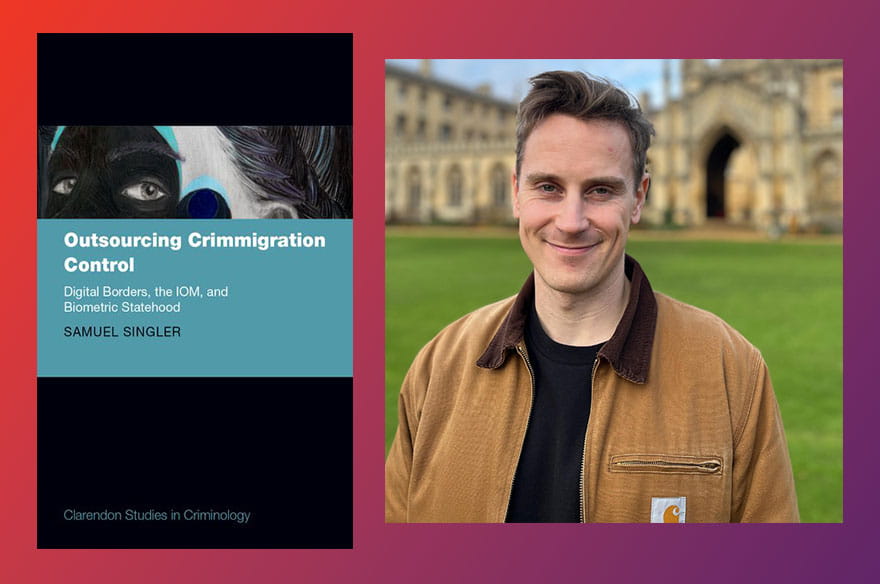Samuel Singler: Q&A on Open Access Publication

Dr Samuel Singler, lecturer in the Department of Sociology and Criminology, recently published his monograph Outsourcing Crimmigration Control: Digital Borders, the IOM and Biometric Statehood with Oxford University Press.
A detailed study of real-world issues around border control and surveillance, it is a timely topic which Dr Samuel Singler joined us to discuss.
Outsourcing Crimmigration Control: Digital Borders, the IOM and Biometric Statehood is freely available to download now.

Congratulations on your monograph! How does it feel to see it available online and in print?
Thank you – it feels incredible! This is my first monograph, so it’s surreal to finally see it out in the world. I’m also happy with the timing of the book; questions regarding border control, surveillance, and criminal justice feel more relevant than ever.
When did you begin work on it and was it always intended to be a monograph?
This research began as my PhD project in 2019. Back then, I really had no idea what the final product would look like – I certainly couldn’t imagine publishing a book a few years later.
Your work focuses on Abuja in Nigeria. What led you there in particular and how long did you spend in the region?
I first settled on the case study: the Migration Information and Data Analysis System (MIDAS), which is a digital border management technology now used in 29 countries globally. The fieldwork location was determined later, once I had a sense of how MIDAS has been deployed in practice. Nigeria currently hosts the most extensive rollout of MIDAS, so it offers a key case study of how digitalization has shaped border control practices on the ground.
Can you introduce us to some of the terms you use: crimmigration, digital borders, IOM?
I’ll do these in reverse order:
- IOM stands for the International Organization for Migration. The IOM is a highly influential actor shaping migration management practices globally. It’s a UN-affiliated agency that provides various kinds of support to its Member States, including the provision of digital border management tools like MIDAS. Despite its global reach and importance, the organization has only recently attracted sustained academic attention.
- In my book, I use the term “digital borders” to refer to border control practices that are carried out using digital technologies. Digital borders range from relatively mundane systems like passport gates to more complicated tools like automated risk assessment algorithms. One key characteristic of digital borders—as many researchers and activists have pointed out—is that they tend to diffuse across space and time. Borders no longer operate only at interstate boundaries; databases, risk management tools, and identity management systems can enact migration control practices far away from actual border zones, as well as both before and long after geographical borders have been crossed.
- “Crimmigration” is a term used by criminologists to describe the legal, practical, and technical merger of crime control and migration control. In several countries, criminologists have shown that immigration has become subject to increased criminalization on one hand, and on the other hand crime control and security goals have been pursued through border control practices like detention, deportation, and geographical exclusion. This merger can be legally and ethically questionable if the protections usually enshrined in criminal justice systems—like due process, the presumption of innocence, and the right to appeal—are undermined in pursuit of more exclusionary migration control goals.
Are you sounding an alarm with this book, warning that taken too far digital techniques and intense surveillance will unfairly restrict people’s rights?
Many other academics and activists have already sounded the alarm regarding expansive surveillance based on biometric recognition and risk assessment algorithms, both at the border and in criminal justice contexts more broadly. In response, the developers of new technologies and policymakers usually argue that these tools are essentially neutral, that they provide efficient solutions to policy ‘problems’, and that they can be effectively regulated.
In my book, I show that ethical and political decisions regarding the proper scope of digital surveillance cannot be considered only after new tools are already developed and in use. Instead, these decisions shape the entire process of technology design, and systems meant to provide ‘neutral’ solutions are always already based on particular (and contestable) views of the problem they are meant to solve. For instance, digital borders are often developed under the assumption that border control practices should prioritize logics of security and crime control over alternative values such as facilitation and the protection of human rights.
Of course, new technologies can be used in many different ways, to pursue different kinds of goals. Nonetheless, the initial technical design of any technology significantly shapes how it will be used in the future. A hammer, for instance, would make for a painstaking writing instrument, while it would be difficult to drive nails into wood using a pencil.
Have you published Open Access before, and when did you first hear about the University’s Open Access Fund?
I have published several articles Open Access. It is a wonderful way to ensure that our research is available to a wide audience globally. Critical criminological research can only have a real-world impact if is it read, but unfortunately journal paywalls can hinder the reach of otherwise excellent research. Open Access is particularly important when developing arguments about rectifying global hierarchies through decolonising and Southernising research, as the obstacles to accessing academic outputs are unequally distributed on a global level.
I first heard about the University’s Open Access Fund through our wonderful Social Sciences Librarian, Sandy Macmillen, who provides excellent support with finding, accessing, and managing research resources. I initially found it hard to believe the fund could cover the Open Access publication of an academic monograph, but here we are! I am delighted.
How did you find the Open Access process? What advice would you give anyone considering the same route?
Once I had secured a book contract from OUP, I was required to fill in a very simple online form by the Library’s Open Access team. Once my application had been accepted, I asked OUP to amend the initial contract to reflect the new Open Access publication route.
The whole process was incredibly easy – my only advice is to get in touch with the Library Open Access team early as possible to consider what Open Access options are available.
Do you use any Open Access or Open Educational Resources in your own teaching?
Yes, I use several Open Access books and journals across my reading lists.
How do you plan to take advantage of Open Access to share and publicise your book?
Open Access makes disseminating the book effortless, as I can simply share the link to the digital version to anyone interested (and proactively to anyone I think might be interested…).
As I prepare to promote the book across a series of public seminars and academic conferences, I find myself in a wonderful position: there’s no need to convince anyone to part with any cash, as I can tell everyone: “don’t buy it, it’s free!”
Outsourcing Crimmigration Control: Digital Borders, the IOM and Biometric Statehood can be downloaded free of charge now.
The Open Access Fund
The Open Access Fund continues to help Essex researchers publish monographs and chapters Open Access. Check whether the fund can support your publication by completing our brief form, or contact the team at oapublish@essex.ac.uk





